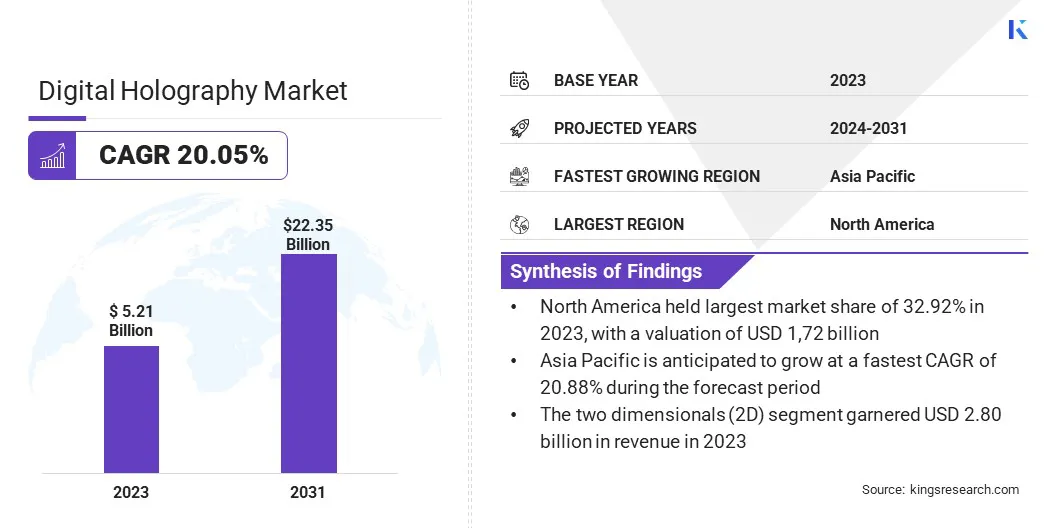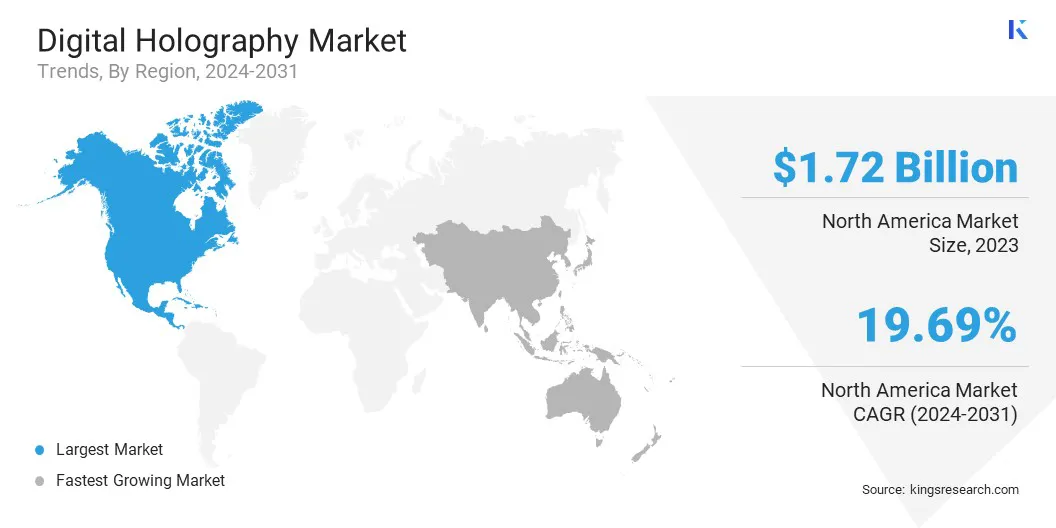Market Definition
The market focuses on the use of digital techniques to capture, store, and reconstruct holograms. It combines optics, imaging, and digital signal processing to provide high-precision 3D imaging. This technology is widely used in fields like microscopy, metrology, and industrial inspection, offering improved accuracy over traditional methods.
Applications extend to areas such as biomedical research, quality control, and virtual reality, where precise and real-time imaging is essential. The report identifies the principal factors contributing to the market expansion, along with an analysis of the competitive landscape influencing its growth trajectory.
Digital Holography Market Overview
The global digital holography market size was valued at USD 5.21 billion in 2023 and is projected to grow from USD 6.22 billion in 2024 to USD 22.35 billion by 2031, exhibiting a CAGR of 20.05% during the forecast period.
The market is strongly driven by the increased focus on biomedical applications, where precise 3D imaging is critical for cellular research and diagnostics. Additionally, the miniaturization of devices is making digital holography systems more accessible, expanding their adoption across medical, industrial, and research sectors.
Major companies operating in the digital holography industry are Lyncée Tec SA, PHI Optics, Inc., JENOPTIK AG, Shimadzu Corporation, Holovision, Inc., Zygo Corporation, LEUKOS GmbH, Optics11 B.V., Microsystems & Engineering, Inc., TeamHolography, Inc., Holo/OR Ltd., Nanolive SA, HoloTech Switzerland AG, FEMTOprint SA, and OptoMet Technologies.
The market is largely driven by continuous advancements in imaging technologies. Digital holography has achieved higher resolution and accuracy with improvements in sensors, light sources, and computational power.
These technological innovations allow for the capturing of detailed 3D images, crucial for applications in fields like biomedical research, industrial inspections, and quality control. The evolving capabilities of digital imaging hardware directly support the growth of the market.
- In March 2025, researchers from South Korea developed a digital holography processor, capable of converting two-dimensional (2D) videos into real-time three-dimensional (3D) holograms. This advancement significantly enhances the resolution and accuracy of digital holography, enabling detailed 3D imaging, crucial for applications in biomedical research, industrial inspections, and quality control.
 Key Highlights
Key Highlights
- The digital holography industry size was valued at USD 5.21 billion in 2023.
- The market is projected to grow at a CAGR of 20.05% from 2024 to 2031.
- North America held a market share of 32.92% in 2023, with a valuation of USD 1.72 billion.
- The hardware segment garnered USD 3.16 billion in revenue in 2023.
- The two dimensional (2D) segment is expected to reach USD 11.70 billion by 2031.
- The holographic microscopy segment secured the revenue share of 34.27% in 2023.
- The education segment is poised for a robust CAGR of 21.94% through the forecast period.
- The market in Asia Pacific is anticipated to grow at a CAGR of 20.88% during the forecast period.
Market Driver
"Increased Focus on Biomedical Applications"
The growth of the digital holography market is supported by the rising demand for high-precision imaging in the biomedical sector. Digital holography enables the detailed 3D imaging of biological samples, allowing researchers to observe cellular structures in real time without the need for invasive procedures.
This capability is especially valuable in drug discovery, clinical diagnostics, and laboratory research, driving further adoption in healthcare applications and fostering market expansion.
- In March 2025, researchers at Johns Hopkins University developed a digital holographic imaging (DHI) system capable of detecting nanometer-scale tissue deformations associated with neural activity. This non-invasive technology illuminates neural tissues with a laser and records the scattered light to identify and validate signals that indicate neural activity, offering a novel approach to brain-computer interfaces.
Market Challenge
"High Cost and Complexity of Digital Holography Systems"
A significant challenge in the digital holography market is the high cost and complexity associated with the technology. The advanced equipment required for high-resolution 3D imaging can be expensive, limiting its accessibility for smaller research labs and businesses. Additionally, the systems can be difficult to operate and maintain, requiring specialized training.
Key market players are focusing on developing more affordable and user-friendly solutions by improving the efficiency of their systems and leveraging miniaturization.
Some players are also offering software packages that simplify the operation, reducing the need for technical expertise and making digital holography more accessible to a broader audience.
Market Trend
"Miniaturization of Devices"
The trend toward the miniaturization of digital holography devices has significantly contributed to the growth of the digital holography market. Smaller, portable devices that are capable of capturing high-quality holograms are increasingly being developed.
These compact systems allow for greater flexibility and ease of use in various applications, from field inspections to on-site medical diagnostics. The market is registering considerable growth as the demand for portable and efficient holography solutions rises.
- In January 2025, Holoconnects unveiled the Holobox Mini at CES 2025. This tabletop-sized holographic display device projects real-time 3D holograms, offering a compact solution for showcasing products and engaging experiences in smaller spaces. Its portability and ease of use make it ideal for various applications, from retail displays to interactive installations.
Digital Holography Market Report Snapshot
|
Segmentation
|
Details
|
|
By Offering
|
Hardware, Software
|
|
By Dimension
|
Two Dimensional (2D), Three Dimensional (3D)
|
|
By Application
|
Holographic Microscopy, Holographic Imaging, Holographic Telepresence, Others
|
|
By End User
|
Healthcare, Automotive, Aerospace & Defense, Education, Consumer Electronics, Entertainment, Others
|
|
By Region
|
North America: U.S., Canada, Mexico
|
|
Europe: France, UK, Spain, Germany, Italy, Russia, Rest of Europe
|
|
Asia-Pacific: China, Japan, India, Australia, ASEAN, South Korea, Rest of Asia-Pacific
|
|
Middle East & Africa: Turkey, U.A.E., Saudi Arabia, South Africa, Rest of Middle East & Africa
|
|
South America: Brazil, Argentina, Rest of South America
|
Market Segmentation
- By Offering (Hardware, Software): The hardware segment earned USD 3.16 billion in 2023, due to the increasing demand for advanced imaging systems, which require high-performance cameras, sensors, and optical components for precise 3D visualizations.
- By Dimension (Two Dimensional (2D), Three Dimensional (3D)): The Two Dimensional (2D) segment held 53.76% share of the market in 2023, due to its cost-effectiveness, simplicity, and suitability for a wide range of applications, including surface measurement and quality control in various industries.
- By Application (Holographic Microscopy, Holographic Imaging, Holographic Telepresence, and Others): The Holographic Microscopy segment is projected to reach USD 7.80 billion by 2031, owing to its critical role in advanced biomedical research, offering precise, label-free 3D imaging of living cells.
- By End User (Healthcare, Automotive, Aerospace & Defense, Education, Consumer Electronics, Entertainment, Others): The Education segment is poised for significant growth at a CAGR of 21.94% through the forecast period, due to the increasing adoption of advanced imaging techniques in research and academic institutions.
Digital Holography Market Regional Analysis
Based on region, the market has been classified into North America, Europe, Asia Pacific, Middle East & Africa, and South America.
 North America digital holography market share stood at around 32.92% in 2023, with a valuation of USD 1.72 billion. North America has a robust research and development (R&D) infrastructure that plays a key role in boosting the market.
North America digital holography market share stood at around 32.92% in 2023, with a valuation of USD 1.72 billion. North America has a robust research and development (R&D) infrastructure that plays a key role in boosting the market.
Universities, research institutes, and private companies are investing heavily in developing advanced holography technologies. These efforts focus on enhancing the resolution, speed, and efficiency of digital holography systems.
In August 2025, the Optica Digital Holography and Three-Dimensional Imaging Topical Meeting will be held in Seattle, Washington, U.S. This event, a part of the Optica Imaging Congress, will provide a forum for scientists, technologists, and industry leaders to discuss the advancements in digital holography and 3D imaging technologies. The meeting aims to foster collaboration and innovation in the field, highlighting North America's role in driving R&D in digital holography.
Moreover, the healthcare and biomedical sectors in North America are among the primary drivers of the market. The technology’s ability to produce detailed, 3D images of cells and tissues without altering the samples makes it invaluable in medical research and clinical applications, thus accelerating the market's growth in the region.
The digital holography industry in Asia Pacific is poised for significant growth at a robust CAGR of 20.88% over the forecast period. The market is growing, due to the presence of a strong electronics manufacturing base in the region.
Major electronics hubs are increasingly adopting digital holography for precise inspection of semiconductors, circuit boards, and microcomponents. Manufacturers seek high-speed, non-contact measurement methods to maintain quality and production efficiency. The widespread need for detailed surface inspection and error detection in mass production processes is fueling the market across Asia Pacific.
Regulatory Frameworks
- In the U.S., digital holography devices intended for medical use are regulated by the FDA under 510(k) or PMA processes. Systems handling personal health data must comply with HIPAA standards. The export of certain high-tech imaging technologies is governed by the Export Administration Regulations (EAR) under the Bureau of Industry and Security.
- The European Union (EU) regulates digital holography systems under the Medical Device Regulation (MDR), which mandates strict safety and performance requirements. Products must achieve CE marking for market entry. Handling of any personal data through holography devices must fully comply with GDPR guidelines, ensuring the stringent protection of user and patient information.
- In China, the National Medical Products Administration (NMPA) requires digital holography systems used in healthcare to pass strict registration and certification processes. Personal data handling, especially in medical imaging applications, must comply with the Personal Information Protection Law (PIPL), which sets detailed conditions for data collection, use, storage, and transfer.
- India’s Central Drugs Standard Control Organization (CDSCO) manages approvals for digital holography systems classified as medical devices. Data privacy is currently guided by existing IT rules, with the anticipated Personal Data Protection Bill, expected to enforce stricter controls. Compliance will be critical for healthcare and industrial holography applications in India.
Competitive Landscape
Market players are actively focusing on developing advanced digital holography systems and improving core technologies to stay competitive. These efforts are directly supporting the growth of the digital holography industry.
Companies are streamlining imaging processes and enhancing system performance, which helps in expanding their practical use across sectors like healthcare, research, and manufacturing.
- In February 2025, Honeywell introduced a digital holographic microscopy system that produces high-resolution images without the need for traditional lenses and opto-mechanical systems. By generating unfocused holograms with light passing through a sample and processing them with computational algorithms, this technology simplifies imaging processes, making it accessible for biomedical applications.
List of Key Companies in Digital Holography Market:
- Lyncée Tec SA
- PHI Optics, Inc.
- JENOPTIK AG
- Shimadzu Corporation
- Holovision, Inc.
- Zygo Corporation
- LEUKOS GmbH
- Optics11 B.V.
- Microsystems & Engineering, Inc.
- TeamHolography, Inc.
- Holo/OR Ltd.
- Nanolive SA
- HoloTech Switzerland AG
- FEMTOprint SA
- OptoMet Technologies
Recent Developments (Product Launch)
- In October 2024, Lyncée Tec introduced a high-Q stroboscopic module for its digital holographic microscopes. This innovation enables ultra-precise measurements of phononic crystal resonances, achieving frequency resolutions of 1 part per billion and vertical displacement sensitivity below 1 picometer.

 Key Highlights
Key Highlights North America digital holography market share stood at around 32.92% in 2023, with a valuation of USD 1.72 billion. North America has a robust research and development (R&D) infrastructure that plays a key role in boosting the market.
North America digital holography market share stood at around 32.92% in 2023, with a valuation of USD 1.72 billion. North America has a robust research and development (R&D) infrastructure that plays a key role in boosting the market.